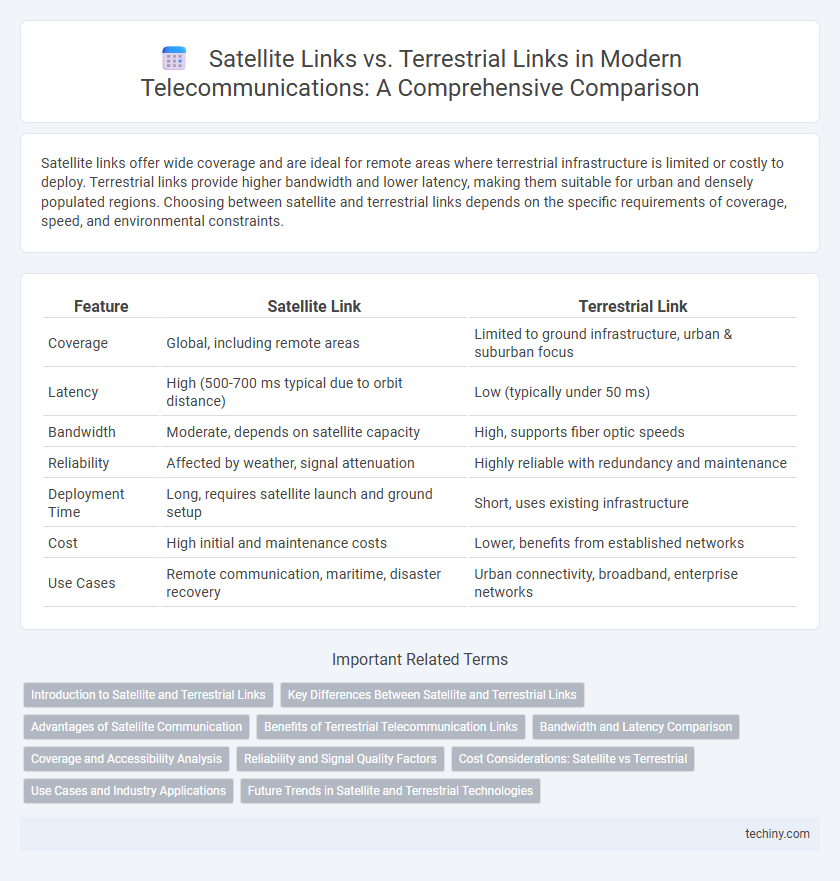Satellite links offer wide coverage and are ideal for remote areas where terrestrial infrastructure is limited or costly to deploy. Terrestrial links provide higher bandwidth and lower latency, making them suitable for urban and densely populated regions. Choosing between satellite and terrestrial links depends on the specific requirements of coverage, speed, and environmental constraints.
Table of Comparison
| Feature | Satellite Link | Terrestrial Link |
|---|---|---|
| Coverage | Global, including remote areas | Limited to ground infrastructure, urban & suburban focus |
| Latency | High (500-700 ms typical due to orbit distance) | Low (typically under 50 ms) |
| Bandwidth | Moderate, depends on satellite capacity | High, supports fiber optic speeds |
| Reliability | Affected by weather, signal attenuation | Highly reliable with redundancy and maintenance |
| Deployment Time | Long, requires satellite launch and ground setup | Short, uses existing infrastructure |
| Cost | High initial and maintenance costs | Lower, benefits from established networks |
| Use Cases | Remote communication, maritime, disaster recovery | Urban connectivity, broadband, enterprise networks |
Introduction to Satellite and Terrestrial Links
Satellite links utilize orbiting satellites to transmit signals over vast distances, enabling global communication coverage including remote and underserved areas. Terrestrial links rely on ground-based infrastructure such as fiber optics, microwave towers, and copper cables to provide high-speed, low-latency communication within localized or regional networks. Key factors influencing the choice between satellite and terrestrial links include latency, bandwidth capacity, environmental susceptibility, and deployment cost.
Key Differences Between Satellite and Terrestrial Links
Satellite links provide wide-area coverage through geostationary or low Earth orbit satellites, enabling connectivity in remote and underserved regions, while terrestrial links rely on physical infrastructure like fiber optics, microwave, or copper cables for localized, high-capacity transmission. Latency in satellite links tends to be higher due to the long distances signals travel to and from satellites, whereas terrestrial links offer lower latency, which is crucial for real-time applications. Cost structures also differ significantly: satellite communication involves higher initial setup and operational costs but reduced ground infrastructure, while terrestrial links require extensive ground-based investment but offer higher bandwidth and scalability in urban areas.
Advantages of Satellite Communication
Satellite communication offers extensive coverage, including remote and rural areas where terrestrial infrastructure is limited or unavailable. It supports rapid deployment for emergency response and global broadcasting without the need for physical cables. The technology also provides reliable connectivity over vast distances, reducing latency concerns compared to undersea fiber optic cables.
Benefits of Terrestrial Telecommunication Links
Terrestrial telecommunication links offer superior data transmission speeds and lower latency compared to satellite links, making them ideal for real-time applications and high-volume data transfer. These links benefit from greater reliability and consistent signal quality, unaffected by weather conditions or atmospheric interference that commonly impact satellite communications. Infrastructure advancements in fiber optic and microwave technologies further enhance terrestrial networks' capacity, scalability, and cost-effectiveness for urban and rural connectivity.
Bandwidth and Latency Comparison
Satellite links typically offer lower bandwidth compared to terrestrial links due to spectrum limitations and the long distances signals must travel. Latency in satellite communications is significantly higher, often around 500 milliseconds, caused by signal propagation delays between Earth and orbiting satellites. Terrestrial links like fiber optic cables provide much higher bandwidth and minimal latency, usually under 10 milliseconds, enabling faster and more reliable data transmission.
Coverage and Accessibility Analysis
Satellite links provide extensive coverage across remote, rural, and maritime areas where terrestrial infrastructure is limited or nonexistent, enabling communications in underserved regions. Terrestrial links, including fiber optics and microwave towers, offer higher reliability and lower latency in urban and suburban zones but depend heavily on physical infrastructure and terrain conditions. Accessibility in satellite communication is enhanced by line-of-sight coverage from orbit, whereas terrestrial links face challenges such as urban obstructions and geographic barriers limiting their reach.
Reliability and Signal Quality Factors
Satellite links often face signal degradation due to atmospheric conditions like rain fade and solar interference, impacting overall reliability compared to terrestrial links. Terrestrial links benefit from stable infrastructure and shorter transmission distances, leading to higher signal quality and lower latency. However, satellite links provide broader coverage in remote areas where terrestrial networks are limited, balancing reliability with accessibility challenges.
Cost Considerations: Satellite vs Terrestrial
Satellite links typically incur higher initial capital expenditures due to expensive satellite transponder leasing and ground station infrastructure, yet offer cost advantages in covering remote or rural areas where terrestrial deployment costs escalate sharply. Terrestrial links, including fiber optic and microwave, demand substantial investment in physical infrastructure like cables, towers, and rights-of-way, leading to higher maintenance costs but lower latency and greater bandwidth capacity at scale. Cost efficiency between satellite and terrestrial links depends critically on geographic coverage, user density, and deployment scale, with satellite favored for wide, low-density regions and terrestrial preferred in urban high-density environments.
Use Cases and Industry Applications
Satellite links enable global connectivity in remote, maritime, and disaster recovery scenarios where terrestrial infrastructure is unavailable or damaged. Terrestrial links dominate urban and suburban environments, supporting high-capacity broadband, mobile networks, and enterprise connectivity with lower latency and higher data rates. Industries such as defense, aviation, and oil & gas rely on satellite links for reliable communication, while finance, healthcare, and smart cities predominantly utilize terrestrial networks for critical low-latency applications.
Future Trends in Satellite and Terrestrial Technologies
Advancements in satellite link technologies are driving higher throughput with low Earth orbit (LEO) mega-constellations reducing latency and enhancing global coverage, supporting 5G and beyond. Terrestrial link innovations focus on millimeter-wave frequencies and massive MIMO to boost capacity and network densification in urban areas. Integration of satellite and terrestrial networks through software-defined networking (SDN) and network function virtualization (NFV) is paving the way for seamless, hybrid connectivity solutions.
Satellite Link vs Terrestrial Link Infographic

 techiny.com
techiny.com